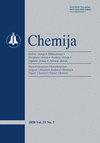A novel strategy to develop electrochemical atrazine sensor
IF 0.4
4区 化学
Q4 CHEMISTRY, MULTIDISCIPLINARY
引用次数: 0
Abstract
Determination of pesticides is important for human health. Sensors are one of the best solutions because they do not require a long sample preparation and can be used not only in a laboratory. Electrochemical sensors can be easily minimised and employed for the detection of pesticides in liquid samples such as ground or wastewater. Conducting polymers have a few roles in electrochemical sensors, therefore, they can be good candidates for sensor development. Electrochemically co-polymerised folic acid and riboflavin as well as folic acid and L-lysine were employed for the detection of atrazine using square wave voltammetry. The co-polymer composition was optimised and characterised electrochemically and spectroscopically. The optimal composition of polyfolic acid and poly-L-lysine co-polymer electrosynthesised from the monomer ratio 1:10 was the best in terms of stability and sensitivity to atrazine. The best method was the square wave voltammetry showing the best sensitivity to atrazine 198 ± 1 μA/μM cm2, and the limit of detection was 14.8 nM. However, the sensitivity in tap water was significantly lower but still suitable for atrazine detection by the spike method.一种开发电化学阿特拉津传感器的新策略
农药的测定对人类健康很重要。传感器是最好的解决方案之一,因为它们不需要长时间的样品制备,而且不仅可以在实验室中使用。电化学传感器可以很容易地最小化并用于检测液体样品(如地面或废水)中的农药。导电聚合物在电化学传感器中有一些作用,因此,它们可以成为传感器开发的良好候选者。采用电化学共聚合叶酸和核黄素以及叶酸和L-赖氨酸的方波伏安法检测阿特拉津。对共聚物组合物进行了优化,并对其进行了电化学和光谱表征。从稳定性和对阿特拉津的敏感性来看,由单体比例1:10电合成的聚叶酸和聚赖氨酸共聚物的最佳组成是最好的。最佳方法是方波伏安法,其对阿特拉津的灵敏度为198±1μA/μM cm2,检测限为14.8 nM。然而,自来水中的灵敏度明显较低,但仍然适用于刺突法检测阿特拉津。
本文章由计算机程序翻译,如有差异,请以英文原文为准。
求助全文
约1分钟内获得全文
求助全文
来源期刊

Chemija
化学-化学综合
CiteScore
1.30
自引率
16.70%
发文量
14
审稿时长
>12 weeks
期刊介绍:
Chemija publishes original research articles and reviews from all branches of modern chemistry, including physical, inorganic, analytical, organic, polymer chemistry, electrochemistry, and multidisciplinary approaches.
 求助内容:
求助内容: 应助结果提醒方式:
应助结果提醒方式:


